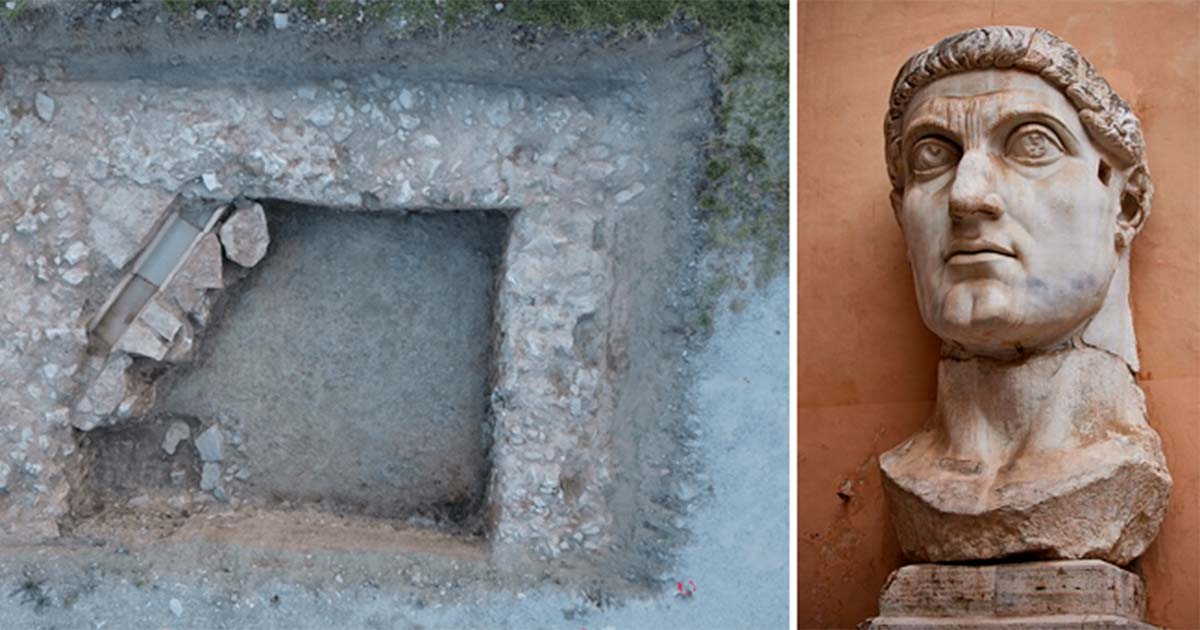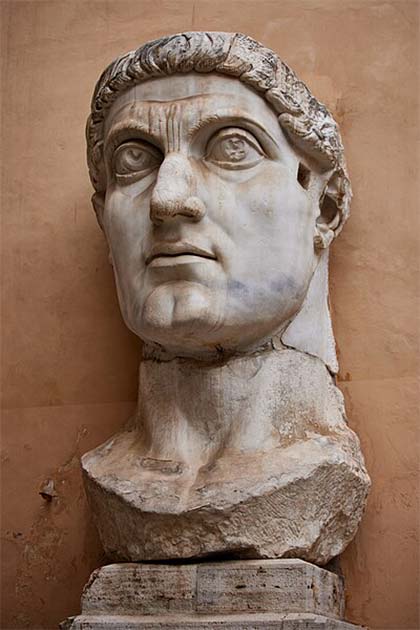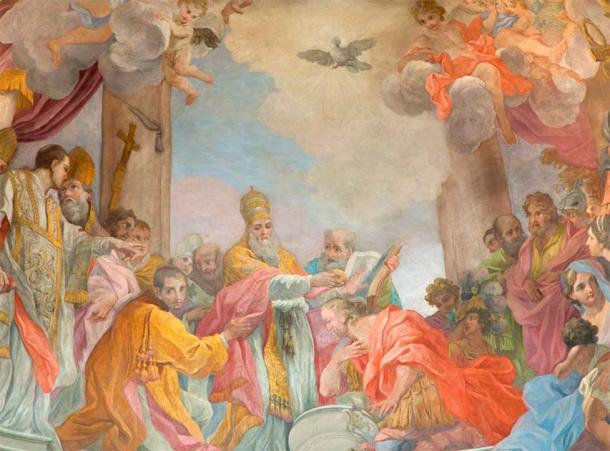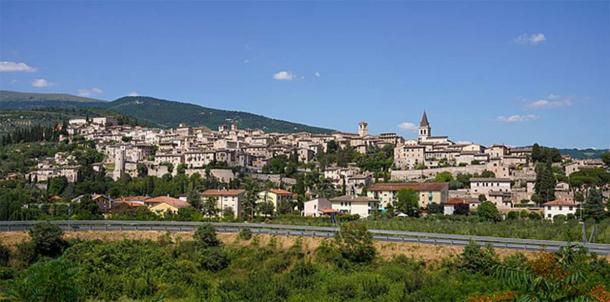Pagan Temple Shifts Rome’s Narrative of Rapid Conversion to Christianity
The ruins of an ancient pagan temple under a parking lot in central Italy 70 miles (112.65 km) north of Rome, sheds light on the cultural shift during the transition from Roman imperial theology to Christianity. The structure has been dated to the era of the Roman emperor Constantine, who ruled Rome between 306 and 337 AD, whose reign is marked by being the first Roman emperor to officially convert to Christianity.

The temple was found in Spello, Italy, as part of The Spello Project, an international effort to uncover the lost history of the ancient town formerly known as Hispellum. The announcement was made by Douglas Boin, a history professor at Saint Louis University, during the Archaeological Institute of America meeting in Chicago, according to a press release by Saint-Louis University.
Constantine’s Conversion to Christianity: A Watershed Moment
The excavation team, led by Boin, discovered three walls of the monumental structure using underground imaging. The significance of the finding is connected to a concession made by Roman Emperor Constantine during the fourth century. In a letter inscribed in Spello’s Town Hall, Constantine allowed the townspeople to celebrate a religious festival in Spello, which had transformed into a Roman colony in 1st century BC, instead of traveling long distances.
- Disbelieve it or Not, Ancient History Suggests That Atheism is as Natural to Humans as Religion
- Wealth and Religion Tied through Time: Was Ancient Religious Morality Spurred by Affluence?

Colossal marble head of Roman Emperor Constantine the Great, 4th century, located in the Capitoline Museums in Rome. (D. Benjamin Miller/CC0)
To facilitate this, he instructed the town to erect a temple dedicated to his alleged divine ancestors, the Flavian dynasty. The Flavian family, associated with notable constructions like the Colosseum, was chosen by Constantine for their reputation for good administration amid the empire’s multicultural population.
Constantine’s conversion to Christianity marked a significant moment in Roman history because, at the time, the majority of the Roman Empire followed the Roman imperial cult (officially, it would still be 70 years more till Christianity became the official religion). Boin emphasizes the historical significance of Constantine ruling over an empire with a diverse religious landscape.
“For Constantine to embrace Christianity is a milestone in the history of the Roman Empire,” Boin said. “But what is also a milestone is that he inherited an empire that was not Christian. So, the fascinating historical window that his reign provides is how a ruler of one faith rules or governs an empire where the majority of citizens don’t necessarily subscribe to the same belief that he does.”

Fresco of the Baptism of Emperor Constantine in main apse of church Chiesa di San Silvestro in Capite by Pope Sylvester by Ludovico Gimignani. (Renáta Sedmáková /Adobe Stock)
Support of Imperial Cult by Christian Rulers: Gradual Transition?
Boin explained that there is evidence from various locations across the Roman world indicating the support of imperial cult practices by Christian rulers. The worship of pagans at their temples during the fourth century has been previously acknowledged, albeit in small and inconsequential findings. It has also been established that Christians endorsed the imperial cult, but the specific locations of such occurrences were not known, reports Cosmos Magazine.
The discovery of this temple connects these two significant points, making it distinct from any other temple known from the Mediterranean world of the fourth century Roman Empire. He emphasized that any examination of the imperial cult in the fourth century Roman Empire will now need to consider this temple, representing an extraordinary discovery.

Panoramic view of Spello, the ancient town previously known as Hispellum, where the ruins of an ancient pagan temple was found. (WikiRomaWiki/CC BY-SA 4.0)
“This changes everything about how we perceive the pace of social change and our impression of the impact of social and cultural change,” Boin said. “This building, in a very radical way on its own, shows us the staying power of the pagan traditions that had been on the ground for centuries prior to the rise of Christianity, and it shows us how the Roman emperors continued to negotiate their own values, their own hopes and dreams for the future of the emperor and the Empire without knocking down or burying the past.”
A notable religious continuity existed between the Roman world and the early Christian world, emphasizing that changes did not occur overnight. Prior to their discovery, there was no indication of the existence of tangible, religious sites linked to the late ‘imperial cult practice.’ Owing to the inscription and its mention of a temple, Spello presented a tantalizing possibility for a significant revelation of an Imperial cult beneath Christian rule, reports Newsweek.
- The true meaning of Paganism
- Capela do Senhor da Pedra: The Pagan Origins of the Chapel of the Lord of Stone
In the Roman world, there existed no separation between religion and state. The Romans’ strong sense of patriotism influenced all of their public endeavors, including their worship. In an empire characterized by linguistic diversity, a population spread across three continents, and the preservation of various local traditions, the imperial cult served to unite people under shared ideals. In no way was transition some smooth overnight process but a blend of strange detours and odd cultural mixing, unlikely to have had the full backing of members of either the temple or the church.
“We are on the cusp of giving people a very visible piece of evidence that really upends the neat and tidy ways people think about big moments of cultural change. Cultural changes are never as big as we think they are when living through them, and there’s a lot of gray area in between people’s customs and the broader society and culture. And a lot of those can be left out of the story. So to have this temple potentially be a temple dedicated to Constantine’s divine ancestors as a way to worship the emperor in an increasingly Christian world at the time, it’s so weird and I love that we can bring it to light,” concluded Boin.
Boin and team plan to return to Spello in the summer to finish excavating the entire area and examine the temple further.
Top image: An aerial image depicting the interior walls of a Roman temple found in Spello, Italy, which experts believe to be an ancient pagan temple of fourth-century Italy and the late Roman Empire. Source: Douglas Boin/Saint Louis Univiersity
By Sahir Pandey
Related Post
A shocking documentary proves that mermaids do exist
SHOCKING Revelation: Thuya, Mother of Queen Tiye, Was the Grandmother of Akhenaten and Tutankhamun—What Ancient Egyptian Secrets Did She Leave Behind?
Breaking News: Astonishing Discoveries at Karahan Tepe Confirm an Extraterrestrial Civilization is Hiding on Earth, and NO ONE Knows!
Breaking News: Researchers FINALLY Discover U.S. Navy Flight 19 After 75 Years Lost in the Bermuda Triangle!
NASA’s Secret Investigation: Uncovering the Astonishing Mystery of the UFO Crash on the Mountain!
Explosive UFO Docs LEAKED: Startling Proof That Aliens Ruled Ancient Egypt!